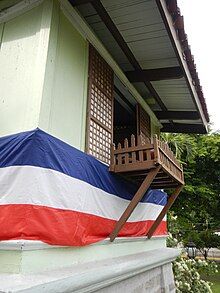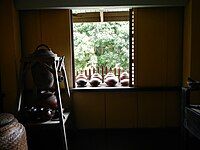Banggéra

In Philippine architecture, the banggéra, also known as the bánggerahán, is a feature in a kitchen or dining room of a bahay kubo or bahay na bato, originating from a time when public drainage systems were still uncommon.[1][2]
Basically a counter space made of slatted wood that protrudes from the kitchen or dining room to the back lawn, it would serve as the house's dish-washing space and air-drying rack for newly washed cookware, kitchen utensils, and tableware before these were stored in a sideboard (platera) or cupboard (pamingganan). Newly washed cups would typically be inverted on the ends of wooden sticks and the plates placed between or above the slats.[1][3][2]
Because the banggéra is made of slatted wood, it is a source of natural light which enters the counter space [4]
Tapáyan
[edit]
As the banggéra is an architectural feature from a time before the introduction of indoor plumbing, commonly associated with it is the tapáyan (also called bangâ), an earthenware jar that stores water and keeps it cool; this jar typically had its place on the far left or right of the slatted counter.
Very often, a dipper would be found on top of a plate that would serve as the lid of the jar, and moss surrounding an old tapáyan would also often be left alone to contribute to the cooling of the jar's contents. Before the era of tap water, drinking water for storing in the tapáyan were sourced from either nearby wells or natural springs.[2][4]
Gallery
[edit]-
An extra long banggéra at the Apolinario Mabini Shrine in Santa Mesa, Manila
-
Banggéra at the Ciriaco Coronel Ancestral House in Santa Ana, Manila containing modern dining implements
-
Banggéra at the Rizal Shrine in Calamba, Laguna which contains many palayok, a traditional earthenware pot used for cooking
See also
[edit]References
[edit]- ^ a b Martinez, Glenn (August 21, 2018). "Here's A Complete List Of The 46 Parts of A Filipino House". Realliving.net. Retrieved August 28, 2024.
- ^ a b c Dy-Metilla, Arch Gloryrose (August 3, 2020). "Banggera". Filipina Architect. Retrieved August 28, 2024.
- ^ Ramos, Grace C. (2000). "The Urban Development and Housing Act (UDHA) of 1992: A Philippine Housing Framework" (PDF). lth.se. Retrieved August 28, 2024.
- ^ a b Gonzaga-Ocampo, Telly (January 30, 2022). "Banggerahan Then and Now". Bohol Tribune (in American English and Cebuano). Retrieved August 29, 2024.





